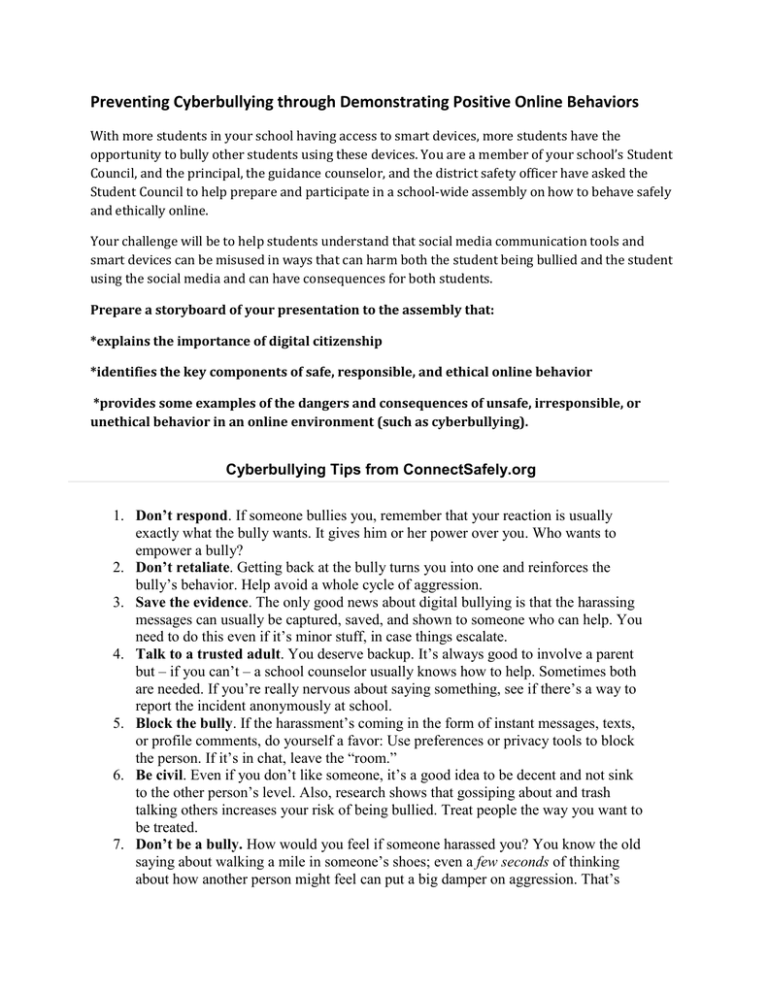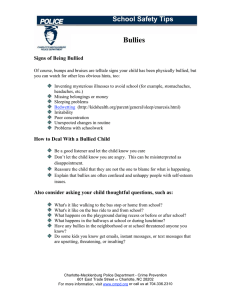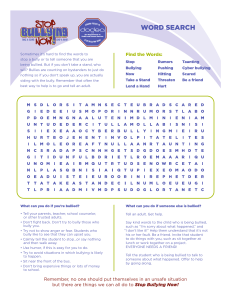Preventing Cyberbullying through Demonstrating Positive Online Behaviors
advertisement

Preventing Cyberbullying through Demonstrating Positive Online Behaviors With more students in your school having access to smart devices, more students have the opportunity to bully other students using these devices. You are a member of your school’s Student Council, and the principal, the guidance counselor, and the district safety officer have asked the Student Council to help prepare and participate in a school-wide assembly on how to behave safely and ethically online. Your challenge will be to help students understand that social media communication tools and smart devices can be misused in ways that can harm both the student being bullied and the student using the social media and can have consequences for both students. Prepare a storyboard of your presentation to the assembly that: *explains the importance of digital citizenship *identifies the key components of safe, responsible, and ethical online behavior *provides some examples of the dangers and consequences of unsafe, irresponsible, or unethical behavior in an online environment (such as cyberbullying). Cyberbullying Tips from ConnectSafely.org 1. Don’t respond. If someone bullies you, remember that your reaction is usually exactly what the bully wants. It gives him or her power over you. Who wants to empower a bully? 2. Don’t retaliate. Getting back at the bully turns you into one and reinforces the bully’s behavior. Help avoid a whole cycle of aggression. 3. Save the evidence. The only good news about digital bullying is that the harassing messages can usually be captured, saved, and shown to someone who can help. You need to do this even if it’s minor stuff, in case things escalate. 4. Talk to a trusted adult. You deserve backup. It’s always good to involve a parent but – if you can’t – a school counselor usually knows how to help. Sometimes both are needed. If you’re really nervous about saying something, see if there’s a way to report the incident anonymously at school. 5. Block the bully. If the harassment’s coming in the form of instant messages, texts, or profile comments, do yourself a favor: Use preferences or privacy tools to block the person. If it’s in chat, leave the “room.” 6. Be civil. Even if you don’t like someone, it’s a good idea to be decent and not sink to the other person’s level. Also, research shows that gossiping about and trash talking others increases your risk of being bullied. Treat people the way you want to be treated. 7. Don’t be a bully. How would you feel if someone harassed you? You know the old saying about walking a mile in someone’s shoes; even a few seconds of thinking about how another person might feel can put a big damper on aggression. That’s needed in this world. 8. Be a friend, not a bystander. Watching or forwarding mean messages empowers bullies and hurts victims even more. If you can, tell bullies to stop or let them know harassment makes people look stupid and mean. It’s time to let bullies know their behavior is unacceptable – cruel abuse of fellow human beings. If you can’t stop the bully, at least try to help the victim and report the behavior.





